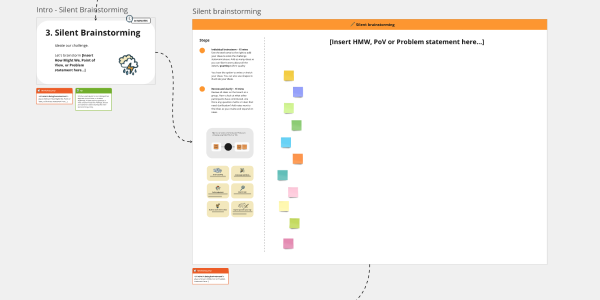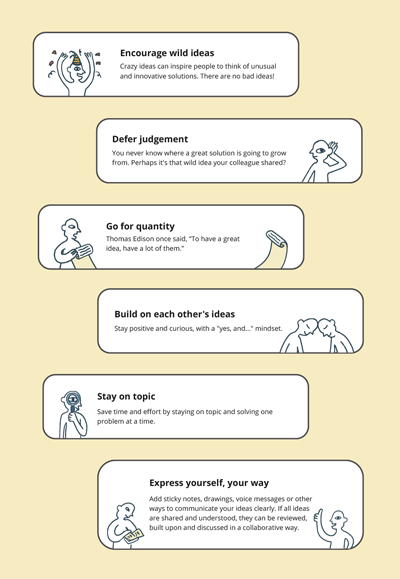Prep
For this play, there is a small amount of preparation required to help your participants understand the goal and get the most out of the session.
You will need to gather some insights about the problem space the team are working on, reframed as a “how might we...” or problem statement.
Run the how might we play to help create one before going ahead with Silent Brainstorming.
Invite your participants
Aim for including a range of people to form a multi-disciplinary team. The more diverse the experiences and perspectives of the people around the table, the richer the ideation outcomes will be.
Participants in this session should be made up of the project team and any subject matter experts relevant to the project. This might include a Project Manager (PM), Project Officer, Designer, Business Analyst, Communications Officer, Solution Architect, or Developer. You can still run the session if you don't have all of these team members available but aim for as much diversity as possible.
You’ll want to make sure when you send an invite for the session, that you clearly explain the goal, how long it’ll take, and why people’s participation will be beneficial. You can use the provided template to make it easy. If you have already created a “how might we...” question in an earlier session, including the same participants to the brainstorming session is beneficial so that they get a chance to share their ideas.
It’s important to give enough notice to ensure participants have free time to come along to the session. Aim to send invitations about 2 weeks in advance.
You can also attach the play for people to look at ahead of time
Calendar meeting request for silent brainstorming
Subject:
Join us for a silent brainstorming session for [project name]
Meeting description:
Hi [team name if sending a group invitation, or participant name if sending individual invitations]
As part of [name of project] we have recently defined a [problem or how might we] statement and are looking to generate some new and innovative solutions.
The session will take about [x] minutes and there is no preparation required.
Having [you/each of you] attend will help to generate a large number of potential ideas that can be developed into testable prototypes or experiments. We will be [using Miro for this workshop/gathering in-person] and you can read more about the silent brainstorming session in the Digital service design playbook.
I look forward to your contribution to the session. [If you’re planning to record the session include the following - We will be recording the session for learning and development purposes and recordkeeping. Please let us know before the session if you don't want to be included in the recording or transcript].
The [Project name] team is committed to inclusion for our workshops, and we appreciate the experience of inclusion is not the same for everyone. Please let us know what we can do to make our sessions more accessible and inclusive for you.
Kind Regards,
[Facilitator name]
Setting up the tools
For remote teams, use this Miro board: Silent Brainstorm Miro.
For in-person teams, you will need a booked meeting space, sticky notes (one pad per participant), markers (one for each participant) and a whiteboard, wall, or butcher paper to attach the sticky notes. Even if you are working in-person, consider reviewing the Miro template to get an idea of how we suggest running the Play.






